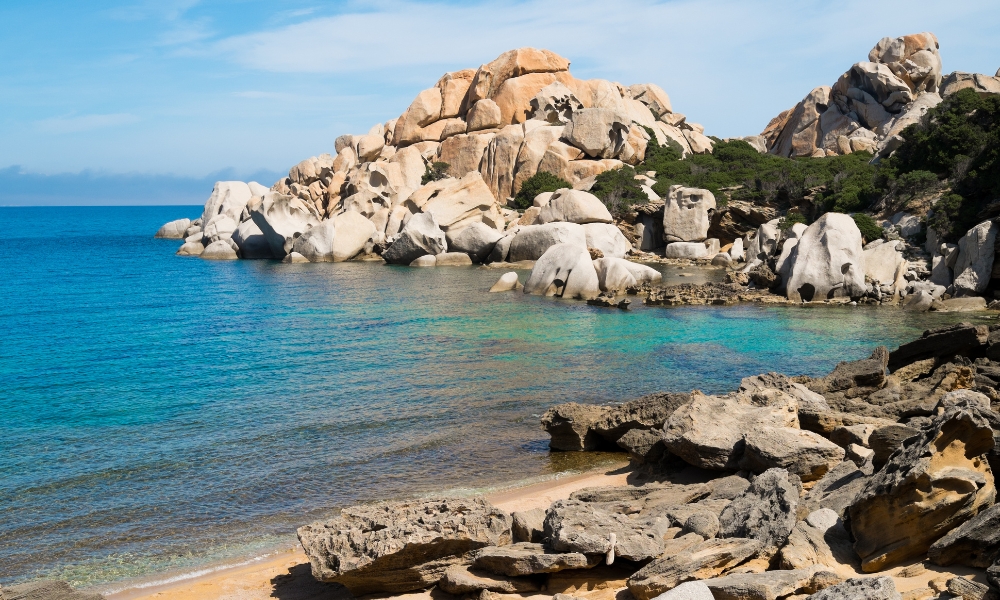Savor the Authentic Taste of Rome in Testaccio
 Image Name: Idyllic Shores of the Mediterranean
Image Name: Idyllic Shores of the Mediterranean
When you picture Rome, the Colosseum, the Pantheon, or the busy alleys around the Trevi Fountain come easily. One less-known gem, though, provides a deeper, more real sense of the metropolis. Testaccio, tucked away on the left bank of the Tiber River, has long been a favorite area for residents for its rich cultural legacy and active dining scene. Testaccio presents a sense of Roman life as it is, with residents flocking here for both its gastronomic pleasures and its intriguing past, unlike other areas of Rome that largely serve visitors.
A Feast for Foodies
I brought two friends, Boba and Smiljana, to tour Testaccio on a pleasant fall evening. For first-time guests, this was an amazing diversion from the usual tourist attractions. Particularly on weekends when it stays open late for special food events, Testaccio’s Mercato di Testaccio (Testaccio Market) is a hive of culinary activity. Classic Roman cuisine including carbonara, cacio e pepe, and supplì (deep-fried rice balls) lines the market booths during these festivals. There will also be wines, beers, and lots of music to create a vibrant environment ideal for anyone wishing to savor Roman food culture at its best.
Happy with the realism of it all, Boba said, “Who wants a tourist-trap lunch near the Colosseum when you can eat this?” She was enjoying a famous Roman street meal, slow-roasted pork sandwich, porchetta. Both residents and visitors come to Testaccio for this kind of real dining experience.
The core of Roman culinary tradition
Testaccio is far more than merely a place to eat. There are layers of history buried in this area. Rome’s past is actually layered like a lasagna, with every layer revealing a fresh phase of its development. Underneath the market, for example, is one of Rome’s most amazing archeological finds: an old amphora graveyard where once-buried antique terracotta jars used to carry olive oil, wine, and other commodities. Originally stacked on ships to protect the goods, these amphorae were finally thrown away and let to create Monte Testaccio, a slope of broken pottery. This 35-meter-high mound is a singular monument to Roman trade.
The Historical Emporium
The Emporium, an ancient harbor constructed about 193 BCE, is mostly responsible for the historical relevance of the Testaccio area. Goods from all around the Mediterranean passed into Rome via this huge inland port. Particularly throughout the reigns of emperors like Claudius and Trajan, the area was vital for feeding the expanding Roman population. Here goods including olive oil, wine, and seafood were unloaded; Testaccio developed into a hive of trade.
Archaeologist Luca Mocchegiani Carpano guides visitors through the market’s subterranean areas today, offering intriguing analysis of the port’s past importance. He says that the Tiber River was formerly the main point of access to the city, therefore confirming Testaccio’s significance in ancient times.
 Image Name: Capturing Nature’s Rustic Majesty
Image Name: Capturing Nature’s Rustic Majesty
Culinary Heritage Found in Every Meal
Rich culinary tradition of Testaccio is one of its most identifying characteristics. Using simple materials like offal and leftover meats, the area developed to be the birthplace of cucina povera, the “cuisine of the poor.” One of the most well-known restaurants in the region, Checchino dal 1887, is a shining illustration of this gastronomic history. Originally designed to feed the burgeoning working-class population in the late 19th century, Checchino is well-known for meals like coda alla vaccinara (oxtail stew), a creation formed out of need to use discarded scraps of meat from the nearby slaughterhouse.
The restaurant still has a “historical menu” with classic Roman delicacies including bucatini alla gricia (pasta with cured swine jowl) and insalata di zampi (veal trotters salad). Checchino keeps its modest, rustic appeal despite its Michelin star rating, exactly mirroring the simplicity of Testaccio’s cuisine.
Other family-run eateries in Testaccio, including Da Oio, Felice, and Perilli, keep offering real interpretations of classic Roman cuisine. If you’re feeling bold, try dishes like trippa alla romana (beef tripe topped with Pecorino cheese and mint) or coratella (lamb offal with vegetables). These are tastes that define Testaccio’s character and have made the neighborhood known as the real food lover’s heaven.
Sustainability and a Neighborhood of Change
Testaccio is not exempt from the gentrification afflicting many areas of Rome, even if it still has much of its classic appeal. From a working-class neighbourhood, the region has progressively become one appealing artists, young professionals, and visitors looking for a real Roman experience. Testaccio has nevertheless been able to retain its special identity. One such is the Città dell’Altra Economia (The City of Alternative Economy), a cultural center built in the old slaughterhouse that supports sustainability and organizes gastronomic events honoring local cuisine and products. Held here, the Magna Roma Festival honors Rome’s gastronomic legacy with a contemporary spin.
The gastronomic culture of Testaccio also centers sustainability. Locally created groups such as the Gruppo di Acquisto Solidale Testaccio Meticcio (GAS) purchase organic vegetables straight from producers. These projects guarantee that Testaccio remains a venue where people gather over food, as they have for millennia, therefore preserving the community-driven energy of the neighborhood.
Testaccio
Testaccio is still a refuge for people looking for a real, non-tourist Roman experience even with the developments and increasing appeal among visitors. Rich tapestry of Roman cuisine and culture is created by the market, family-run restaurants, and historic monuments. Here are delicacies that residents have been savoring for centuries, presented in surroundings firmly anchored in history.
Testaccio reminds us of what makes Rome really unique while tourism keeps rising in the city—the close, enduring relationships individuals have with their food, their history, and each other.
Conclusion:
One easily gets lost in the well-traveled roads of important tourist sites while visiting Rome. But Testaccio gives you an opportunity to discover a true, genuine, vibrant side of the city. From rich historical sites to exquisite Roman cuisine, Testaccio is a place where the past and present coexist peacefully to provide an experience you will carry long after you leave. Thus, including Testaccio on your travel plans if you search for a vacation spot with rich history and great cuisine. You won’t be regretting it. Discover the secret tales that define Rome and make this amazing area much more than just a tourist attraction.



